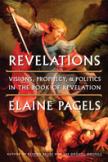World's End
In her writings, Professor Elaine Pagels has popularized Gnostic gospels by crafting stories of spiritually gifted individuals whose insights were rejected by a religious hierarchy adept at wielding political power. Orthodoxy, reinforced by Constantine, eviscerated the spiritually creative impulses in Christianity. Readers taken with her earlier books, Adam, Eve, and the Serpent: Sex and Politics in Early Christianity (1988), and The Origin of Satan (1995), will find this territory familiar.
Even though the same ecclesiastical authorities concluded the Christian Scriptures collected for the New Testament with the Book of Revelation, other visions were lost: “Left out are the visions that lift their hearers beyond apocalyptic polarities to see the human race as a whole—and, for that matter, to see each one of us as a whole, having the capacity for both cruelty and compassion.”
As the final word, she says Revelation has the effect of playing a poisonous role in Christianity. New visions and prophetic leaders take on the demonic guise that John of Patmos employed against imperial Rome. Images of the conquering lamb and the whore of Babylon fueled new outbreaks of religious violence against both outsiders and dissenting Christians. In the American Civil War, the Union sang “Battle Hymn of the Republic,” while Confederates depicted Lincoln in the clutches of the great dragon. In a similar way, the great drama of Revelation encompasses both our worst nightmares and the glorious vision of life emerging beyond death.
Roman Catholics have been conditioned by their liturgy to focus on the visions that occur in the heavens, rather than the chaos and destruction on earth below. Angelic hosts praising God, the lamb with a victory flag on the Easter table, the faithful martyrs, the Blessed Virgin (an image intended by John as Israel) as clothed with the sun with Satan under her heal, the church as bride of Christ, and the heavenly Jerusalem lit by God’s presence—all these are the Catholic images. Pagels acknowledges these elements, but she emphasizes the half of the story that is directed toward or on the earth.
Most scholars agree that Revelation was composed around 90 C.E. Since we lack evidence for official opposition to Christianity, the martyrs mentioned in Revelation must be victims of episodic localized violence. Why then the sustained hostility to Roman imperial rule? Pagels adopts a minority view that John of Patmos would have identified himself and those churches faithful to his teaching as Jewish, whose observance of ritual purity and adherence to Jewish law was the prerequisite to participation in the heavenly court. His antagonism against “false Jews” in Rv 2:9 and 3:9 is directed against Gentile believers in the Pauline churches of Asia Minor who were not observant Jews.
What connects the Jewish visionary ascetic at war with the internal enemy, Pauline Christians, to the anti-Roman polemic beyond some general concern to avoid seduction by an impure world? For Pagels imagination takes over. She fills in the gaps with her own speculation. By imagining that John of Patmos had fled Judea as the Roman troops devastated Jerusalem and burned its Temple some 20 years earlier in 70 C.E., she reads the book as wartime literature. After all, she argues, another Jewish seer whose visions are found in 4 Ezra confronted the revealing angel with his distress over the ruin of Israel’s hopes at about the same time.
However, in the interests of creating a dramatic scenario, Pagels’ narrative is likely to confuse readers. Other scholars support the thesis that those whom Ignatius of Antioch labels “Jews” engaged in false teaching among Christians are actually followers of Jesus practicing what they consider a Jewish way of life. They also point out that these (Christian) Jews have no ties to the actual Jewish communities in Asia Minor. Ignatius indicates that these believers observe the Sabbath (Letter to the Magnesians 9.1-2), while both Ignatius and John of Patmos underline the Lord’s Day (Rv 1:10) as the day of Christian assembly.
Pagel’s sweeping generalizations that line John of Patmos up as a self-identified “Jew,” an advocate of the Hebrew prophetic tradition against Ignatius’ Pauline disdain for the law and hierarchical church order, need serious revision. Of course this inflated rhetoric is not found in the scholarly paper “The Social History of Satan. Part III: John of Patmos and Ignatius of Antioch—Contrasting Visions of God’s People,” that Pagels gave at Princeton in 2005 and has published twice since then.
If the non-scholarly audience is likely to mix up actual Jews with John of Patmos’s Jesus believers who call themselves “Jews,” the situation becomes even worse when Pagels dumps Revelation altogether in favor of assorted Gnostic revelations. One of the key examples, a widely read Secret Book of John, presents a third “John” in the story. He is, in addition to Revelation’s author, John of Patmos, and John, the son of Zebedee, the disciple whose authority helped secure its place in the canon. The general reader will have a hard time keeping track of the rapid run through second- and third-century revelations and their orthodox Christian counterparts and opponents that takes over half-way into the book.
Revelation comes in and out of the story as the Christians face persecution by Roman authorities. In the end, it is spiritual freedom from all forms of domination by authorities, both civil and religious, that Pagels celebrates.
This article also appeared in print, under the headline “World's End,” in the April 9, 2012, issue.








